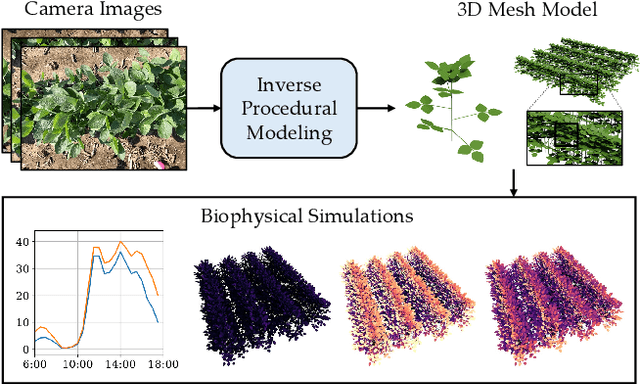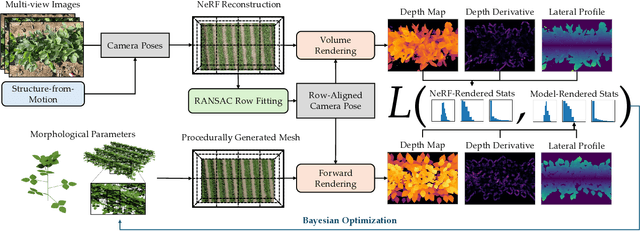Shenlong Wang
VoxelSplat: Dynamic Gaussian Splatting as an Effective Loss for Occupancy and Flow Prediction
Jun 05, 2025Abstract:Recent advancements in camera-based occupancy prediction have focused on the simultaneous prediction of 3D semantics and scene flow, a task that presents significant challenges due to specific difficulties, e.g., occlusions and unbalanced dynamic environments. In this paper, we analyze these challenges and their underlying causes. To address them, we propose a novel regularization framework called VoxelSplat. This framework leverages recent developments in 3D Gaussian Splatting to enhance model performance in two key ways: (i) Enhanced Semantics Supervision through 2D Projection: During training, our method decodes sparse semantic 3D Gaussians from 3D representations and projects them onto the 2D camera view. This provides additional supervision signals in the camera-visible space, allowing 2D labels to improve the learning of 3D semantics. (ii) Scene Flow Learning: Our framework uses the predicted scene flow to model the motion of Gaussians, and is thus able to learn the scene flow of moving objects in a self-supervised manner using the labels of adjacent frames. Our method can be seamlessly integrated into various existing occupancy models, enhancing performance without increasing inference time. Extensive experiments on benchmark datasets demonstrate the effectiveness of VoxelSplat in improving the accuracy of both semantic occupancy and scene flow estimation. The project page and codes are available at https://zzy816.github.io/VoxelSplat-Demo/.
Controllable Weather Synthesis and Removal with Video Diffusion Models
May 01, 2025Abstract:Generating realistic and controllable weather effects in videos is valuable for many applications. Physics-based weather simulation requires precise reconstructions that are hard to scale to in-the-wild videos, while current video editing often lacks realism and control. In this work, we introduce WeatherWeaver, a video diffusion model that synthesizes diverse weather effects -- including rain, snow, fog, and clouds -- directly into any input video without the need for 3D modeling. Our model provides precise control over weather effect intensity and supports blending various weather types, ensuring both realism and adaptability. To overcome the scarcity of paired training data, we propose a novel data strategy combining synthetic videos, generative image editing, and auto-labeled real-world videos. Extensive evaluations show that our method outperforms state-of-the-art methods in weather simulation and removal, providing high-quality, physically plausible, and scene-identity-preserving results over various real-world videos.
DRAWER: Digital Reconstruction and Articulation With Environment Realism
Apr 22, 2025Abstract:Creating virtual digital replicas from real-world data unlocks significant potential across domains like gaming and robotics. In this paper, we present DRAWER, a novel framework that converts a video of a static indoor scene into a photorealistic and interactive digital environment. Our approach centers on two main contributions: (i) a reconstruction module based on a dual scene representation that reconstructs the scene with fine-grained geometric details, and (ii) an articulation module that identifies articulation types and hinge positions, reconstructs simulatable shapes and appearances and integrates them into the scene. The resulting virtual environment is photorealistic, interactive, and runs in real time, with compatibility for game engines and robotic simulation platforms. We demonstrate the potential of DRAWER by using it to automatically create an interactive game in Unreal Engine and to enable real-to-sim-to-real transfer for robotics applications.
Uni4D: Unifying Visual Foundation Models for 4D Modeling from a Single Video
Mar 27, 2025Abstract:This paper presents a unified approach to understanding dynamic scenes from casual videos. Large pretrained vision foundation models, such as vision-language, video depth prediction, motion tracking, and segmentation models, offer promising capabilities. However, training a single model for comprehensive 4D understanding remains challenging. We introduce Uni4D, a multi-stage optimization framework that harnesses multiple pretrained models to advance dynamic 3D modeling, including static/dynamic reconstruction, camera pose estimation, and dense 3D motion tracking. Our results show state-of-the-art performance in dynamic 4D modeling with superior visual quality. Notably, Uni4D requires no retraining or fine-tuning, highlighting the effectiveness of repurposing visual foundation models for 4D understanding.
PhysGen3D: Crafting a Miniature Interactive World from a Single Image
Mar 26, 2025Abstract:Envisioning physically plausible outcomes from a single image requires a deep understanding of the world's dynamics. To address this, we introduce PhysGen3D, a novel framework that transforms a single image into an amodal, camera-centric, interactive 3D scene. By combining advanced image-based geometric and semantic understanding with physics-based simulation, PhysGen3D creates an interactive 3D world from a static image, enabling us to "imagine" and simulate future scenarios based on user input. At its core, PhysGen3D estimates 3D shapes, poses, physical and lighting properties of objects, thereby capturing essential physical attributes that drive realistic object interactions. This framework allows users to specify precise initial conditions, such as object speed or material properties, for enhanced control over generated video outcomes. We evaluate PhysGen3D's performance against closed-source state-of-the-art (SOTA) image-to-video models, including Pika, Kling, and Gen-3, showing PhysGen3D's capacity to generate videos with realistic physics while offering greater flexibility and fine-grained control. Our results show that PhysGen3D achieves a unique balance of photorealism, physical plausibility, and user-driven interactivity, opening new possibilities for generating dynamic, physics-grounded video from an image.
GigaSLAM: Large-Scale Monocular SLAM with Hierachical Gaussian Splats
Mar 11, 2025Abstract:Tracking and mapping in large-scale, unbounded outdoor environments using only monocular RGB input presents substantial challenges for existing SLAM systems. Traditional Neural Radiance Fields (NeRF) and 3D Gaussian Splatting (3DGS) SLAM methods are typically limited to small, bounded indoor settings. To overcome these challenges, we introduce GigaSLAM, the first NeRF/3DGS-based SLAM framework for kilometer-scale outdoor environments, as demonstrated on the KITTI and KITTI 360 datasets. Our approach employs a hierarchical sparse voxel map representation, where Gaussians are decoded by neural networks at multiple levels of detail. This design enables efficient, scalable mapping and high-fidelity viewpoint rendering across expansive, unbounded scenes. For front-end tracking, GigaSLAM utilizes a metric depth model combined with epipolar geometry and PnP algorithms to accurately estimate poses, while incorporating a Bag-of-Words-based loop closure mechanism to maintain robust alignment over long trajectories. Consequently, GigaSLAM delivers high-precision tracking and visually faithful rendering on urban outdoor benchmarks, establishing a robust SLAM solution for large-scale, long-term scenarios, and significantly extending the applicability of Gaussian Splatting SLAM systems to unbounded outdoor environments.
Map Space Belief Prediction for Manipulation-Enhanced Mapping
Feb 28, 2025Abstract:Searching for objects in cluttered environments requires selecting efficient viewpoints and manipulation actions to remove occlusions and reduce uncertainty in object locations, shapes, and categories. In this work, we address the problem of manipulation-enhanced semantic mapping, where a robot has to efficiently identify all objects in a cluttered shelf. Although Partially Observable Markov Decision Processes~(POMDPs) are standard for decision-making under uncertainty, representing unstructured interactive worlds remains challenging in this formalism. To tackle this, we define a POMDP whose belief is summarized by a metric-semantic grid map and propose a novel framework that uses neural networks to perform map-space belief updates to reason efficiently and simultaneously about object geometries, locations, categories, occlusions, and manipulation physics. Further, to enable accurate information gain analysis, the learned belief updates should maintain calibrated estimates of uncertainty. Therefore, we propose Calibrated Neural-Accelerated Belief Updates (CNABUs) to learn a belief propagation model that generalizes to novel scenarios and provides confidence-calibrated predictions for unknown areas. Our experiments show that our novel POMDP planner improves map completeness and accuracy over existing methods in challenging simulations and successfully transfers to real-world cluttered shelves in zero-shot fashion.
LIFe-GoM: Generalizable Human Rendering with Learned Iterative Feedback Over Multi-Resolution Gaussians-on-Mesh
Feb 13, 2025Abstract:Generalizable rendering of an animatable human avatar from sparse inputs relies on data priors and inductive biases extracted from training on large data to avoid scene-specific optimization and to enable fast reconstruction. This raises two main challenges: First, unlike iterative gradient-based adjustment in scene-specific optimization, generalizable methods must reconstruct the human shape representation in a single pass at inference time. Second, rendering is preferably computationally efficient yet of high resolution. To address both challenges we augment the recently proposed dual shape representation, which combines the benefits of a mesh and Gaussian points, in two ways. To improve reconstruction, we propose an iterative feedback update framework, which successively improves the canonical human shape representation during reconstruction. To achieve computationally efficient yet high-resolution rendering, we study a coupled-multi-resolution Gaussians-on-Mesh representation. We evaluate the proposed approach on the challenging THuman2.0, XHuman and AIST++ data. Our approach reconstructs an animatable representation from sparse inputs in less than 1s, renders views with 95.1FPS at $1024 \times 1024$, and achieves PSNR/LPIPS*/FID of 24.65/110.82/51.27 on THuman2.0, outperforming the state-of-the-art in rendering quality.
Task-Parameter Nexus: Task-Specific Parameter Learning for Model-Based Control
Dec 17, 2024Abstract:This paper presents the Task-Parameter Nexus (TPN), a learning-based approach for online determination of the (near-)optimal control parameters of model-based controllers (MBCs) for tracking tasks. In TPN, a deep neural network is introduced to predict the control parameters for any given tracking task at runtime, especially when optimal parameters for new tasks are not immediately available. To train this network, we constructed a trajectory bank with various speeds and curvatures that represent different motion characteristics. Then, for each trajectory in the bank, we auto-tune the optimal control parameters offline and use them as the corresponding ground truth. With this dataset, the TPN is trained by supervised learning. We evaluated the TPN on the quadrotor platform. In simulation experiments, it is shown that the TPN can predict near-optimal control parameters for a spectrum of tracking tasks, demonstrating its robust generalization capabilities to unseen tasks.
CropCraft: Inverse Procedural Modeling for 3D Reconstruction of Crop Plants
Nov 14, 2024



Abstract:The ability to automatically build 3D digital twins of plants from images has countless applications in agriculture, environmental science, robotics, and other fields. However, current 3D reconstruction methods fail to recover complete shapes of plants due to heavy occlusion and complex geometries. In this work, we present a novel method for 3D reconstruction of agricultural crops based on optimizing a parametric model of plant morphology via inverse procedural modeling. Our method first estimates depth maps by fitting a neural radiance field and then employs Bayesian optimization to estimate plant morphological parameters that result in consistent depth renderings. The resulting 3D model is complete and biologically plausible. We validate our method on a dataset of real images of agricultural fields, and demonstrate that the reconstructions can be used for a variety of monitoring and simulation applications.
 Add to Chrome
Add to Chrome Add to Firefox
Add to Firefox Add to Edge
Add to Edge